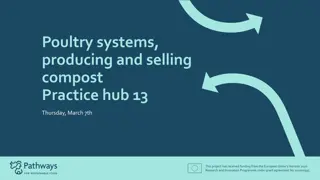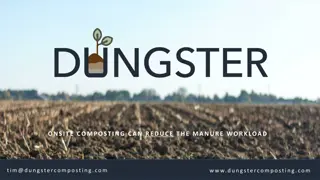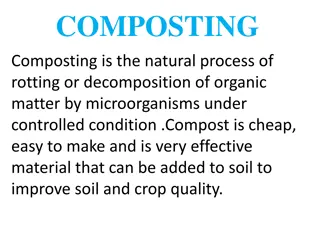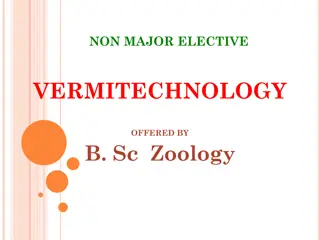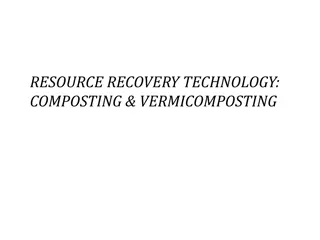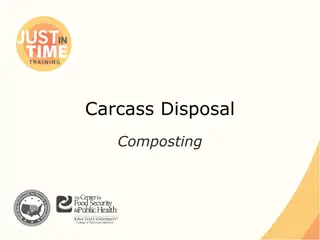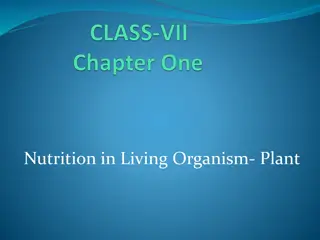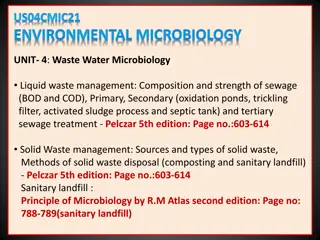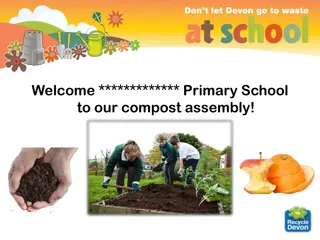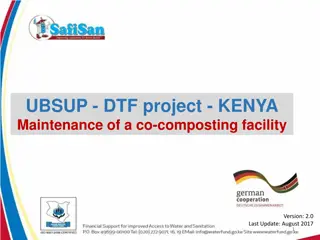Understanding the Fundamentals of Composting
Compost is organic matter decomposed into a valuable fertilizer and soil amendment. The process involves aerobic decomposition of waste material, turning it into nutrient-rich humus. Composting requires a mix of organic matter, water, air, and proper carbon:nitrogen ratio for efficient breakdown. The end product, compost, is beneficial for gardening, landscaping, and agriculture, serving as a natural soil conditioner and fertilizer. Learn about the essential components, phases, and benefits of composting in this comprehensive guide.
Download Presentation

Please find below an Image/Link to download the presentation.
The content on the website is provided AS IS for your information and personal use only. It may not be sold, licensed, or shared on other websites without obtaining consent from the author. Download presentation by click this link. If you encounter any issues during the download, it is possible that the publisher has removed the file from their server.
E N D
Presentation Transcript
COMPOST Compost is organic matter that has been decomposed and recycled as a fertilizer and soil amendment. Composting of waste is an aerobic method of decomposing solid wastes. Composting is a natural process that turns organic material into a dark rich substance (humus). is a good fertilizer for plants. Compost is a key ingredient in organic farming.
The process of composting requires making a heap of wet organic matter known as green waste (leaves, food waste) and waiting for the materials to break down into humus after a period of weeks or months. Modern composting is a multi-step, closely monitored process with measured inputs of water, air, and carbon and nitrogen-rich materials. The decomposition process is aided by shredding the plant matter, adding water and ensuring proper aeration by regularly turning the mixture.
Worms and fungi further break up the material. Aerobic bacteria and fungi manage the chemical process by converting the inputs into heat, carbon dioxide, and ammonium. The ammonium (NH+4) is the form of nitrogen used by plants. When available ammonium is not used by plants it is further converted by bacteria into nitrates (NO 3) through the process of nitrification.
Compost is rich in nutrients. It is used in gardens, landscaping, horticulture, and agriculture. The compost itself is beneficial for the land in many ways, including as a soil conditioner, a fertilizer, and a natural pesticide for soil.
Fundamentals of composting Carbon, nitrogen, oxygen, water Microorganisms Phases of composting Slow and rapid composting Pathogen removal
1. Carbon, nitrogen, oxygen, water Composting organisms require four equally important ingredients to work effectively: Carbon for energy; the microbial oxidation of carbon produces the heat. Nitrogen to grow and reproduce more organisms to oxidize the carbon. Oxygen for oxidizing the carbon. Water in the right amounts to maintain activity without causing anaerobic conditions.
C:N RATIO The most efficient composting occurs with an optimal carbon:nitrogen ratio. Should be 30 parts carbon to 1 part nitrogen by weight (30:1) Mixing equal parts by volume approximates the ideal C:N range.
2. Microorganisms There are many types of microorganisms found in active compost of which the most common are: Bacteria---------- The most numerous of all the microorganisms found in compost. mesophilic or thermophilic bacteria. Actinobacteria- ----------- for breaking down paper products such as newspaper, bark, etc. Fungi- molds and yeast ------------ break down lignin in woody material. Protozoa- ----------Help consume bacteria, fungi and micro organic particulates. Rotifers- ------control populations of bacteria and small protozoans. Earthworms---------- in vermicultures
3.Phases of composting Latent phase (Ambient temperature 22 C). Composting microbes infiltrate, colonize and acclimatize to the material. Growth phase (22 40 C). Growth and reproduction of microbes, resulting in a high respiration rate and consequent elevation of temperature to a mesophilic range. Thermophilic phase (40 60 C). Compost pile achieves peak temperature and maximum pathogen sterilization. At the end of this phase the temperature drops to around 40 C. Maturation phase (40 C ambient). Slower, secondary mesophilic phase, with the temperature gradually dropping to ambient temperature as the microbial activity within the material decreases. Complex organic chemicals are transformed into humic compounds and residual ammonia undergoes nitrification to nitrite and subsequently nitrate.
4. Slow and rapid composting traditional methods-------- slow-----months Rapid By controlling carbon-to-nitrogen ratio (C:N) at 30 to 1, more homogenized and smaller pieces in the compost, monitoring the moisture level more carefully- ------------ made within 2 to 3 weeks
5. Pathogen removal Composting can destroy pathogens or unwanted seeds. Unwanted living plants (or weeds) can be discouraged by covering with compost.
We can use following for composting: Yard waste Kitchen scraps Newspaper Cardboard Organic solid waste Animal manures Human waste and sewage sludge We can t use the following: Meat scraps Bones Dairy products Pet waste Diseased plants Invasive weeds
CARE OF COMPOST Concerns Solutions I don t have room Use commercial bin It takes too long Maintain proper conditions Cut up large pieces It smells Not if you maintain C:N ratio Temps too low to kill diseases, fungi, weed seeds Use local community composting facility for problem pieces, compost the rest Attracts animals Bury food waste in center
ADVANTAGES Early stages as mulch Keeps weeds from growing Helps retain moisture Beneficial minerals go into soil Later stages for soil amending Enriches soil Helps with moisture retention Reduces need for chemical fertilizers that leach into our ground water
KINDS OF COMPOSTING oBin composting oTumbler composting oSunken pail composting oSheet composting oAnaerobic composting oVermi composting
1. 2. Bin composting what most people do Tumbler commercial bin that rotates when turned every day, produces compost in about a month small size need multiple tumblers or you have a stretch when you can t compost good for kitchen waste Sunken pail Good for kitchen waste 5 gal pails with drainage holes in the bottom buried almost to top and covered When full, throw some dirt in and close up By the time you fill up a second bucket, the first should be done Smelly when open 3.
4. Sheet composting 4 to 6 inches over garden in fall spade into soil in the spring Mulching is sheet composting at its simplest Digging holes and burying waste is sheet composting 5. Anaerobic composting airless, can be done in plastic bags, smelly if bag breaks Good for small quantities Add a few handfuls of dirt Leave in sun and turn every few weeks
6. Vermicomposting using worms Superior nitrogen-rich compost Secrete calcium carbonate which regulates the soil s pH Enzymes they secrete promote growth





